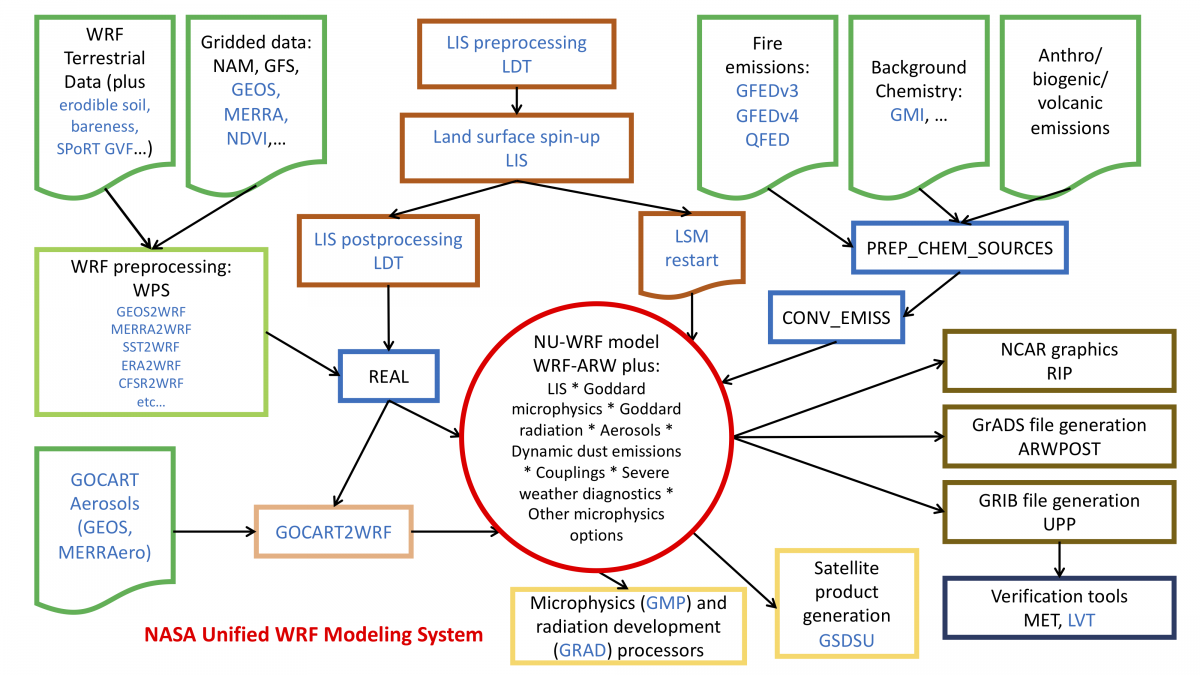NU-WRF System
The NASA-Unified WRF(NU-WRF) modeling system has been developed at Goddard Space Flight Center (GSFC) as an observation-driven integrated modeling system representing aerosol, cloud, precipitation, and land processes at satellite-resolved scales (Peters-Lidard et al., 2014). NU-WRF is intended as a superset of the standard NCAR Advanced Research WRF [WRF-ARW; (Skamarock et al., 2008)] and incorporates:
- The GSFC Land Information System [LIS; see Kumar et al. (2006) and Peters-Lidard et al. (2007)], coupled to WRF and also available as a stand-alone executable;
- The WRF-Chem enabled version of the Goddard Chemistry Aerosols Radiation Transport [GOCART; Chin et al. (2002)];
- GSFC radiation and microphysics schemes including revised couplings to the aerosols (Shi et al., 2014); and
- The Goddard Satellite Data Simulator Unit [G-SDSU; see Matsui et al. (2013) and Matsui et al. (2014)].
In addition, multiple pre- and post-processors from the community and from GSFC have been collected with the NU-WRF model proper. Taken together, the NU-WRF modeling system provides a framework for simulating aerosol and land use effects on such phenomena as floods, tropical cyclones, mesoscale convective systems, droughts, and monsoons. Support also exists for treating CO2 as a tracer, with plans to further refine it into source components (anthropogenic versus biogenic).
Work is underway to add an ensemble Kalman-filter based atmospheric data assimilation system for NU-WRF with the capability of assimilating cloud and precipitation-affected radiances. In addition, some secondary, rarely used elements of the community WRF modeling system are not yet included in NU-WRF but will be added in the future.
USER GUIDE
Complete documentation on the NU-WRF system is available online here. Other user guides for GSDSU, Goddard Radiation Scheme, GOCART dust model sources, and CASA2WRF are also available. A pre-processor to initialize NU-WRF with MERRA2 reanalysis is also available.
NU-WRF components and features are shown in the following flowchart.

Citation:
Peters-Lidard, C.D., E. M. Kemp, T. Matsui, J. A. Santanello, Jr., S. V., Kumar, J. P. Jacob, T. Clune, W.-K. Tao, M. Chin, A. Hou, J. L. Case,, D. Kim, K.-M. Kim, W. Lau, Y. Liu, J.-J. Shi, D. Starr, Q. Tan,, Z. Tao, B. F. Zaitchik, B. Zavodsky, S. Q. Zhang, M. Zupanski (2015), Integrated modeling of aerosol, cloud, precipitation and land processes at satellite-resolved scales, Environmental Modelling & Software, 67, 149–159. doi:http://dx.doi.org/10.1016/j.envsoft.2015.01.007

